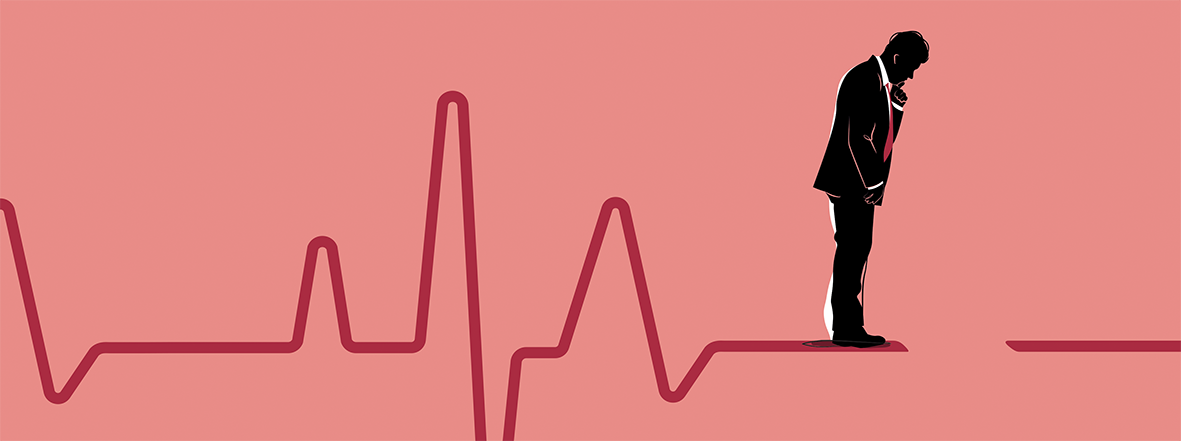Tampere University researchers made a breakthrough – soon we will have a watch that can predict cardiac arrest and sudden death
Our smartwatches already have all the technology needed to predict sudden cardiac death. Only the software is lagging behind.
Original text: Miira Parhiala
Graphics: Carla Ladau
Translation: Oskari Koski

Is it possible that one day we will have a device in our pockets that can make calls, take photos and check Google for the optimal time for cooking eggs?
This is something a bold person might have been envisioning a couple decades ago, before the breakthrough of smartphones.
But even they could not have imagined a watch that notifies you about your messages, tells you how well (or badly) you are sleeping, counts your steps and notifies you when you are about to die.
“That is where we are going,” says the head of the Physics Unit at Tampere University, Professor Esa Räsänen.
Tampere University physicists have developed a new method to estimate the risk of sudden cardiac death based on the heart rate interval as measured during one minute. The study was carried out in collaboration with experts in cardiology and computational physics.
“Based on the measurement of resting heart rate during one minute, we can estimate the risk of heart based sudden death with more accuracy than what is normally possible with a clinical twenty-minute stress test in a hospital,” Räsänen elaborates.
Sudden cardiac death may strike even the young
The first symptom of heart disease is often a heart attack, cardiac arrest or sudden death.
It is commonly known that sudden death may befall even a young person, for example during strenuous exercise. A healthy lifestyle does prevent sudden cardiac deaths, but it does not eliminate the risk.
“A heart condition does not necessarily show any symptoms; instead, the heart might just suddenly tilt,” Räsänen adds.
Alcohol use, smoking and a high body mass – these three factors are unsurprisingly also mentioned in the risk factors for sudden death.
The first symptom of heart disease is often a heart attack, cardiac arrest or sudden death.
However, in the study by Tampere University researchers, these risks were excluded. Instead, they have focused on the analytics of heart rate intervals.
“We’ve looked at what properties specifically in the heart rate intervals increase the risk,” Räsänen says.
The technology is already there
In order to organise preventative care, the risk of sudden cardiac death needs to be defined. Devices that measure pulse, such as smartwatches, already meet the technical requirements in determining heart-based risk factors.

“Technologically, the smartwatches of today are absolutely precise enough. They can already provide precise data on heart rate intervals, which can be used in illness and risk estimations with good analytics,” Räsänen explains.
The software, however, has not yet developed far enough. The method of Tampere University researchers is not yet in our smartwatches, but this will change in the future. According to Räsänen, they already have a cooperation agreement with the well-known Finnish company Suunto.
“It won’t be that long before they will have a new product in relation to this.”
That is all Räsänen can say for now.
Perhaps soon my Apple Watch will also inform me: “beware, you might die!”. Will we soon have in our pockets everything that is needed for the continuation of human life?
Around one hundred sudden deaths in the source material
The study conducted by Tampere University researchers is based on the stress test data of around 4 000 patients gathered in The Finnish Cardiovascular Study (FINCAVAS).
The patients were followed for a period of eight years. If a sudden death occurred on a patient, it was reported.
The data is categorised into non-deceased and deceased patients, which the researchers used to see how well they could predict sudden death based on the resting heart rate measured during one minute.
The risk of sudden death was calculated using a hazard factor. The hazard factor is an often-used measure of relative risk in survival studies.
The individuals in the study were people who had to go to a hospital and take a stress test for one reason or another. According to Räsänen, the patients in the study were on average not specifically young or healthy.
“Nevertheless, a long-term follow-up of thousands of people is a good estimation from a statistical point of view,” Räsänen says.
There were around one hundred sudden deaths in the source material.
The quest to reduce sudden deaths
With the new method developed by Tampere University researchers, it was discovered that patients with abnormal heart rate intervals had a markedly greater risk of sudden death compared to those whose pulse was normal. The analysis also took into account other risk factors.
”The event could have been anticipated and prevented if the appearance of risk factors had been noticed in time.”
This method has a great potential in the early diagnosis of heart disease and in the recognition of high-risk patients. It does not require additional measurements, and it could easily be attached to smart watches or smart rings, which, according to Räsänen, could prevent sudden cardiac deaths.

“It is possible that, in many patients who have not shown symptoms before, who had a sudden cardiac death or who were resuscitated following a sudden heart stoppage, the event could have been anticipated and prevented if the appearance of risk factors had been noticed in time,” comments the cardiology professor and head author of research Jussi Hernesniemi in a bulletin by Tampere University
The new method is based on the analysis that was developed by a research group led by Esa Räsänen. This analysis can be used to study the connection of heart rate intervals at different times as well as other complex features that are typical for heart diseases.
“The most interesting observation is the recognition of differences specifically during resting measurements. At rest, the characteristics of heart rate intervals of high-risk patients resembled the characteristics of a healthy heart under physical exertion,” says the doctoral researcher Teemu Pukkila in the bulletin.
The watch could also recognise heart conditions
Research and development of the method is ongoing in relation to various heart conditions. The goal is to reliably recognise both the total risk of heart diseases as well as the most common heart diseases, such as heart failure, which is quite difficult to diagnose with today’s methods.
The first results are promising, according to Esa Räsänen.
Soon there might be a personal wrist-worn heart doctor on the store shelves. This device that predicts sudden death might even compete with the ever-present information bank in my pocket, that even remembers how long to cook an egg for me.
The study “Prediction of Sudden Cardiac Death With Ultra-Short-Term Heart Rate Fluctuations” was published on 12.6.2024 in the esteemed publication, JACC: Clinical Electrophysiology